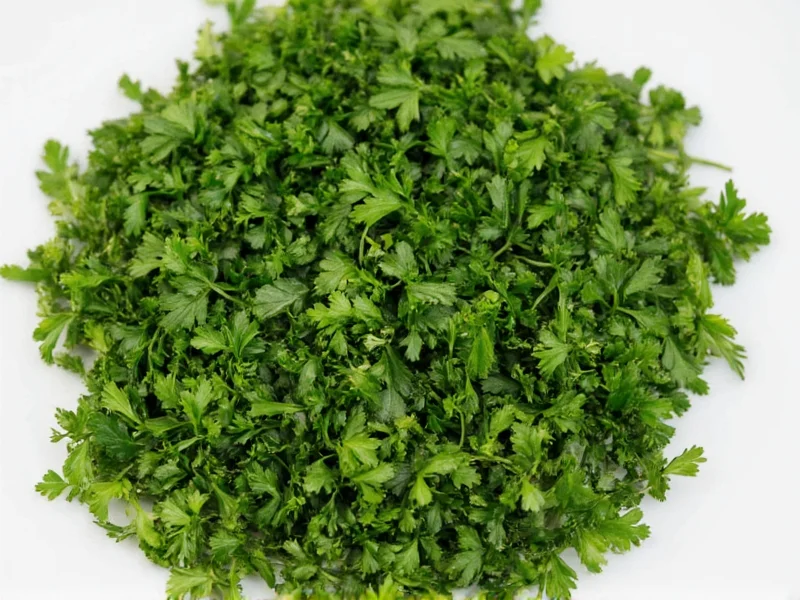When you find yourself without fresh parsley but have dried in your pantry, knowing the precise substitution ratio makes all the difference in recipe success. Many home cooks mistakenly use equal amounts, resulting in either under-seasoned dishes or overpowering herbal notes that ruin carefully balanced flavors.
Understanding the Dried to Fresh Parsley Ratio
Dried parsley contains approximately three times the flavor concentration of fresh parsley because the drying process removes water content while preserving essential oils. This concentration means you need less dried herb to achieve equivalent flavor impact.
| Measurement | Fresh Parsley | Dried Parsley Substitute |
|---|---|---|
| Basic Ratio | 3 parts | 1 part |
| Teaspoon to Tablespoon | 1 tablespoon | 1 teaspoon |
| Cup Measurement | 1 cup | 1/3 cup |
| Small Bunch | 1/4 cup chopped | 1 tablespoon |
When Substitution Works Best
Certain cooking applications handle dried parsley substitution more effectively than others. Understanding these contexts helps you decide when to make the swap and when to seek alternatives:
- Long-simmering dishes (soups, stews, braises) - Dried parsley actually performs better here as it has time to rehydrate and distribute flavor evenly
- Dry rubs and spice blends - Dried parsley integrates more consistently in dry preparations
- Baked savory dishes (quiches, savory breads) - The drying process doesn't negatively impact flavor in these applications
When to Avoid Substituting Dried for Fresh
Not all culinary situations accommodate dried parsley equally well. For these applications, consider alternative herbs or adjust your approach:
- Garnishes - Dried parsley lacks the vibrant color and fresh texture that makes parsley an ideal finishing touch
- Raw applications (salads, chimichurri, pesto) - The texture and flavor profile differ significantly from fresh
- Delicate dishes where subtle herbal notes are crucial - Dried parsley can dominate with its more concentrated flavor
Maximizing Flavor When Substituting
Professional chefs employ specific techniques to optimize dried parsley substitution results. Implement these methods for better outcomes:
Add dried parsley early in the cooking process to allow time for rehydration and flavor integration. For immediate flavor impact in shorter-cooking dishes, bloom your dried parsley by sprinkling it into hot oil or broth for 30-60 seconds before adding other ingredients. This technique releases essential oils more effectively than simply stirring dried herbs into cold ingredients.
When substituting in recipes calling for large amounts of fresh parsley (more than 1/4 cup), consider using slightly less than the standard ratio—about 25% less—to prevent overpowering the dish. Dried herbs sometimes develop slightly different flavor compounds during processing that can be more assertive.
Flavor Profile Differences to Expect
Understanding the flavor differences between dried and fresh parsley prevents disappointment in your culinary results. While both come from the same plant (Petroselinum crispum), the drying process alters certain characteristics:
- Fresh parsley delivers bright, grassy notes with subtle peppery undertones
- Dried parsley develops more earthy, slightly woody characteristics
- The citrus notes present in fresh parsley diminish significantly when dried
- Dried parsley lacks the chlorophyll freshness that makes raw applications appealing
For dishes where the unique bright qualities of fresh parsley are essential, consider supplementing your dried parsley substitution with a small amount of fresh lemon zest or a pinch of celery seed to recapture some of the missing flavor dimensions.
Storage Tips for Optimal Dried Parsley Quality
The effectiveness of your dried parsley substitution depends significantly on proper storage. Dried herbs lose potency over time, affecting your conversion calculations:
Store dried parsley in an airtight container away from light and heat. Properly stored, it maintains optimal flavor for 1-2 years. After this period, you may need to increase the substitution amount by 25-50% to achieve equivalent flavor impact. Test older dried parsley by rubbing a small amount between your fingers—if the aroma is faint, you'll need to use more in your substitution.
Common Substitution Mistakes to Avoid
Even experienced cooks sometimes make critical errors when substituting dried parsley for fresh. Watch for these pitfalls:
- Using equal measurements - This results in dishes that taste overwhelmingly herbal
- Adding dried parsley too late - Without sufficient time to rehydrate, it remains powdery and doesn't distribute flavor evenly
- Not adjusting for recipe moisture content - In very dry recipes, you may need to slightly increase the liquid content when using dried herbs
- Using old, stale dried parsley - This leads to under-seasoned dishes despite following proper ratios
Alternative Substitutes When Parsley Isn't Available
If you lack both fresh and dried parsley, these alternatives work in specific applications:
- Cilantro (use 75% of the amount) - Best in Mexican, Asian, and Latin American dishes
- Chives (use equal amount) - Good for garnishes and creamy dishes
- Dried celery leaf (use 50% of dried parsley amount) - Excellent in soups and stews
- Italian parsley stems (use 50% more than leaf measurement) - When you have stems but no leaves
Professional Chef Recommendations
Many professional kitchens maintain both fresh and dried parsley for different applications. When asked about substitution practices, executive chefs commonly advise:
"For sauces and finishing dishes, always use fresh parsley—the visual appeal and bright flavor can't be replicated. But for stocks, braises, and long-cooking dishes, dried parsley actually provides more consistent flavor distribution. The key is understanding which application you're working with before deciding on substitution." — Chef Michael Rodriguez, Culinary Institute of America Instructor
Final Substitution Guidelines
For perfect results when substituting dried parsley for fresh, follow these comprehensive guidelines:
- Use the 1:3 ratio as your starting point (1 tsp dried = 1 tbsp fresh)
- Adjust downward by 25% for older dried herbs (over 1 year)
- Add dried parsley early in cooking for maximum flavor integration
- Bloom dried parsley in hot fat or liquid before use for immediate dishes
- Consider supplementing with lemon zest for dishes requiring fresh brightness
- Never use dried parsley as a garnish—reserve fresh for visual presentations











 浙公网安备
33010002000092号
浙公网安备
33010002000092号 浙B2-20120091-4
浙B2-20120091-4